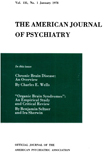TRIFLUOPERAZINE IN CHILDREN AND ADOLESCENTS WITH MARKED BEHAVIOR PROBLEMS
Abstract
In the treatment of 38 emotionally disturbed children and adolescents, one-fifth had Marked Improvement, over half had Moderate Improvement, and one-fifth had Unsatisfactory Improvement. Side effect of slight sleepiness or dizziness occurred in 24%. Trifluoperazine provided the means of reducing hyperactivity, anxiety, and aggressiveness. The drug helped these children become receptive to counseling and other supportive measures, to schooling, to work therapies and to interpersonal relationships.
Access content
To read the fulltext, please use one of the options below to sign in or purchase access.- Personal login
- Institutional Login
- Sign in via OpenAthens
- Register for access
-
Please login/register if you wish to pair your device and check access availability.
Not a subscriber?
PsychiatryOnline subscription options offer access to the DSM-5 library, books, journals, CME, and patient resources. This all-in-one virtual library provides psychiatrists and mental health professionals with key resources for diagnosis, treatment, research, and professional development.
Need more help? PsychiatryOnline Customer Service may be reached by emailing [email protected] or by calling 800-368-5777 (in the U.S.) or 703-907-7322 (outside the U.S.).



